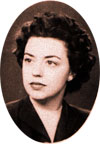Health Professions
“Women in Dentistry” by Elizabeth Neber King, 1945
Elizabeth Neber King, a 1945 graduate of the Washington University School of Dentistry, contributed this article to the August-November 1945 issue of the Washington University Dental Journal. In it she provides a brief history of women in dentistry and of female graduates of the Washington University dental school through the early 1940s.
WOMEN IN DENTISTRY
ELIZABETH NEBER KING, ’45
It hardly seems possible that the wise woman of olden days did not relieve toothaches, just as she helped relieve other ills, but histories of dentistry make no mention whatsoever of women. The modern picture is totally different; the future is more promising. Histories of dentistry will not, in the years to come, remain silent about women’s many efforts and achievements in this branch of the healing art.
The first mention of women in dentistry dates back to 1820 when Levi S. Parmley, according to his book “Natural History of the Teeth,” offered to instruct ladies and gentlemen of liberal education for dental practice. Apparently the ladies did not avail themselves of the opportunity and the subject was unheard of until many years later.
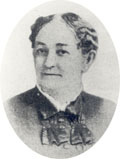 |
| Emeline Roberts Jones, 1836-1916 |
Dr. Emeline Roberts Jones was probably the first woman to practice dentistry in the United States. Married to a dentist, she experimented with extracted teeth to gain experience. She became her husband’s assistant in 1855, and after his death in 1864, she developed a splendid practice in New Haven, Connecticut. In 1893, she was appointed a member of the Women’s Advisory Council of the World’s Columbian Dental Congress. In 1912, she was awarded honorary membership in the Connecticut Dental Society.
 |
| Lucy Hobbs Taylor, 1833-1910 |
Lucy B. Hobbs Taylor, another pioneer, held the distinction of being the first woman to be graduated from a dental college. The community of Ellenberg, N.Y. was shocked in 1859 when she expressed a desire to study dentistry. She was finally successful in finding a dentist (Dr. Wardel of Cincinnati), who gave her a place in his office on equal basis with his other students. She practiced in Iowa and, in 1861, became a member of the Iowa State Dental Society. She was later admitted as a student at the Ohio Dental College upon the recommendation of her Iowa colleagues, and in 1866, was granted a dental degree.
Frau Marie Grubert of Berlin, Germany, was the second woman graduate from that college. She completed the prescribed course in 1872.
Mrs. Fanny A. Rambarger, who graduated from the Pennsylvania College of Dental Surgery in 1874, was the second American woman to receive the degree of Doctor of Dental Surgery. She located in Philadelphia and limited her practice to women and children only.
Gradually, dentistry became more popular among women students, especially Europeans, who, being barred from the schools in their own countries, came to America for an education. On the other hand, American dental schools were not anxious to admit women students. However, by 1880, women were generally accepted in many a dental school. To these pioneer women in dentistry the women dental students of today owe their privileges of education in their chosen profession. At the present time there are only four dental schools in the United States which bar women students. They are Harvard, Georgetown, St. Louis University and the University of Kansas City.
It is interesting to note that Washington University School of Dentistry, as it is now known, though accepting students in 1866, did not consider women as possible matriculants. At a meeting of the faculty, held on the evening of June 1st, 1907, the matter of admitting women to the school was again discussed. “On motion of Dr. H. Prinz it was decided that the experiment of co-education be given a trial by this department, the Faculty reserving the right to, and at any time they should see fit, transfer any and all female matriculants to some other institution.” There is no evidence to show that this motion has ever been reworded or changed in any way since 1907.
 |
| Sophia M. Wachsmuth |
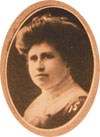 |
| Myrtle L. Jeans |
However, since that time, Washington University School of Dentistry has graduated eighteen women. Of these eighteen, two cannot be traced: Sophia Marie Wachsmuth, ’10, of Munich, Germany (our first woman graduate), and Olga S’Renco, ’11.
Myrtle L. Jeans, also of the Class of 1911, is now deceased after many years of practice in Alton, Illinois. The only other known deceased alumna is Elizabeth Mary Conroy Williams of Belleville, Illinois, who was graduated in 1925.
Dr. Hana Tanabe of Tokyo, Japan, who graduated in 1935, was, on last report, an instructor in the Tokyo Dental School for Women.
 |
| Geneve Riefling |
 |
| Lizzie R. Powell |
There was one woman graduate in 1917, and another in 1918. Geneve Riefling, ’17, is practicing her profession in St. Louis. She is Associate Professor of Children’s Dentistry at the dental school of St. Louis University. Lizzie Rembert Powell, ’18, now Mrs. Harry D’Oench, is also practicing in St. Louis.
 |
| Cornelia Morrison Thompson |
Dr. Cornelia Morrison Thompson of St. Louis, who graduated with the Class of 1922, limits her practice to dentistry for children. She is a staff member of the Municipal Dental Clinic and president of the Missouri Unit of Dentistry for Children Association. Incidentally, it may be also stated that her father, P. Holme Morrison, is a graduate of the Class of 1890, and her grandfather, A. W. Morrison, who gave the profession its first gold shell crown, was a member of the Class of 1869.
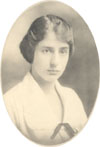 |
| Florence M. Kuhn |
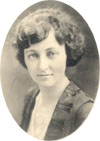 |
| Ruth E. Martin |
Our school graduated two women in 1923: Dr. Florence M. Kuhn of Belleville, Illinois, and Dr. Ruth Martin of St. Louis. Doctor Martin is Associate Professor of Dental Surgery and Director of the Children’s Clinic at her alma mater. She is a member of the staff of Children’s Hospital, president of Gamma Chapter of Omicron Kappa Upsilon, member of the American Society of Dentistry for Children, and a member of the latter’s Curriculum Committee.
 |
| Florence Rich |
Dr. Florence Rich of St. Louis was graduated in 1926. Her practice is limited to children’s dentistry.
In the Class of 1928 there were two women: Dr. Velma Pauline Brown of St. Louis, and Dr. Irene E. Waters of East St. Louis, Illinois.
 |
| Leola C. O’Brien |
 |
| Carolyn M. Reeves |
Not until 1932 did Washington University School of Dentistry graduate another woman, Dr. Leola C. O’Brien of St. Louis. Dr. Carolyn Menkaus Reeves received her degree in 1937, and is in general practice in St. Louis. Dr. Mary Elizabeth Murdoch of the Class of 1938 is practicing the specialty of orthodontics in Wichita, Kansas. Katherine Klein of Clayton, Missouri, received her degree in 1941, and Noleta Thelma Nance of Fayetteville, Ark., received hers in 1942. Both are in general practice.
 |
| Mary Elizabeth Murdoch |
 |
| Katherine Klein |
At the present time, there are five women students at this institution. This, I believe, is the greatest number of women students ever to have been matriculated concurrently, according to our records.
In spite of the fact that women are greatly outnumbered in all dental societies, they have, nevertheless, assumed responsible duties and are creditably discharging them. Mention may be made of Dr. Celia Rich of Nashville, Tennessee, Dr. Lillian Barkann of New York, Dr. Lola Taylor of Alabama, and Dr. Francisca Guerra of Ponce, Puerto Rico. Doctor Guerra is the second woman delegate to the American Dental Association. Dr. Maude M. Tanner, who was thus honored twenty-five years ago, was the first.
Women have achieved prominence in such fields as public health, hospitals, education, and not the least of all, dental education and research. Dr. Vida A. Latham of Chicago, for example, who has worked unremittingly for the recognition of women in dentistry, holds membership in many medical, dental and other scientific organizations both here and abroad, and is well known for her research in biology. Dr. M. Evangeline Jordan of California, is the author of a textbook on children’s dentistry. Dr. Maude M. Tanner of Oregon, is the author of two books on oral hygiene. Dr. Grace Rogers Spalding of Michigan, editor of the American Journal of Periodontology, is very active in post-graduate dental education.
Many women dentists are serving on hospital staffs and dental faculties: Ruth Martin of Washington University, Elsie Gerlack of the University of Illinois, Dorothea Radush of the University of Minnesota, Anna V. Hughes of Columbia University, Geneva Groth and Bertha Eastwood of the University of Pennsylvania, to mention only a few of a long list.
Dentistry is a field which is undermanned. During the past few years the ratio of dentists to the population has considerably decreased. At present the demand for dentistry is greater than ever before. The public is waking up to the realization of the importance of sound teeth in relation to general health.
Generally speaking, there has also been a decline in the number of women dental graduates (1 in 55 practicing dentists is a woman). This may be attributed to the high standards for admission, the increased cost of education, or to interests in other auxiliary fields. However, the future for women in dentistry seems to be promising to those who have the interest, ability, and the determination to succeed.
BIBLIOGRAPHY
Blauch, L. E., Dentistry as a Career, Bull. Chicago Dent. Soc. 16: 5-15, 28, June 11-June 18, 1936.
Institute of Research Chicago, Careers. 1939.
Washington University, St. Louis, Careers in Dentistry.
Dentistry, University of Michigan Official Publications. V. 42, #44, November 30, 1940.
Dentistry as a Life Calling, University of Michigan Official Publications, July 1, 1936.
Sigerist, Henry E., Developments and Trends in Dentistry. Wash. Univ. Dent. J. 7: 131-141, May 1941.
Council of Dental Education, Dentistry as a Professional Career. J.A.D.A. 28: 1328-29, Aug. 4, 1940.
The Occupation of the Dentist, National Occupational Conference, 1939 (Reprint).
Women in Dentistry. J.A.D.A. 15: 1735-56, Sept. 1928.
Carter, Rosalie, Dentistry is a Women’s Job. Independent Women, October 1938.
Woodhouse, C. G., Dental Careers. N. Y., Funk & Wagnalls Co. 1939.
Washington University Dental School. Registration Records.
Washington University Dental School. Graduate Files.
Washington University Dental School. Minutes of the Faculty.
Related Links:
Return to Dentistry (Health Professions)
Return to Health Professions
Back to Top

